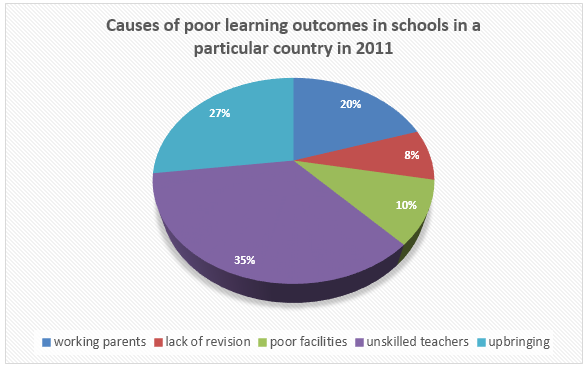You should spend about 20 minutes on this task.
The pie chart below shows the results of a survey of the causes of poor learning outcomes in schools in a particular country in 2011.
Summarise the information by selecting and reporting the main features, and make comparisons where relevant.
You should write at least 150 words.

Sample Answer 1
The pie chart presents a survey result outlining why pupils in schools performed poorly in the country in 2011. Categorically speaking, inexpert teachers and family issues were the main reasons they had tragic outcomes in learning.
In short, unskilled educators, family issues like working parents, improper upbringing of children, insufficient facilities and lack of study and revision were the main reasons schoolgoers’ learning in this country was not up to the mark.
As the data suggests, unskilled masters in schools were the primary ground for young students’ inadequate performance as 35% attribution was made to unskilled teachers. The second most protuberant reason, denoted as 27%, was indicated towards the upbringing of the children, which is related to the family issue. Working-class parents were attributed to influence students learning negatively, as 20% of poor learning results were linked to the bad performance of pupils in schools. Inadequate facilities and lack of revision were pointed out to cause 10 and 8 per cent of this unsatisfactory performance based on the survey outcomes.
Sample Answer 2
The pie graph illustrates why students in a country had substandard results in 2011. There were five main reasons, and unskilled teachers were to take the most blame.
As the diagram suggests, 35% of students did not have good learning outcomes because of some teachers’ lack of experience. On the other hand, family issues accounted for the second-highest percentage of poor learning in school, which was slightly over a quarter. Additionally, precisely one-fifth of students’ poor learning had been due to working parents.
The figure regarding inadequate facilities stood at 10%, slightly higher than that for students’ revision problems. It is worth noticing that there was a difference of 27% between the most common cause – unskilled teachers, and the least – lack of revision. Besides, the former was more than four times when compared with the latter.
Finally, the two main reasons made up more than 60% of poor learning problems while the least popular two reasons only represented lower than 20%.
Sample Answer 3
The pie chart highlights people’s views from a survey of the reasons behind poor academic outcomes in a country in 2011.
People attributed poor performance in schools to several causes. These included working parents, lack of revision, inadequate facilities, unskilled teachers and upbringing. Among all the five listed causes, unskilled teachers were cited by the maximum number of those surveyed at 35%. This was followed by how a child is brought up, a cause quoted by 27% of the poll sample. Only one in five participants ascribed unsatisfactory school results to working parents. Lack of facilities and revision was considered by fewer respondents, 10% and 8%, respectively.
Generally, school-related and home environment-related causes were held accountable for low educational attainment. Notably, the total percentages of people who cited these factors were not significantly different, 53 percent versus 47 percent. However, most participants blamed untrained teachers for below-average academic results.
Sample Answer 4
The pie chart gives the results of a survey regarding the reasons for poor school attendance in 2007 in the UK. As the graph shows, ‘both working parents are the primary reason schools in the UK received poor attendance by students.
It is presented in the pie chart that in 2007 five primary reasons contributed to the fewer students in the UK. According to the survey, the husband and wife who worked both had less attendance, which was the most significant reason not to attend school. 40% absence was the reason for working parents while lack of discipline at school caused 25% absence. 15% of non-attendance was the reason for peer group pressure, while another 15% was for bullying. Finally, 5% of students did not attend school due to their upbringing this year.
In summary, working parents and lack of school discipline were the two main reasons for less attendance in UK schools in 2007.
